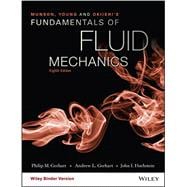NOTE: The Binder-ready, Loose-leaf version of this text contains the same content as the Bound, Paperback version.
Fundamentals of Fluid Mechanic, 8th Edition offers comprehensive topical coverage, with varied examples and problems, application of visual component of fluid mechanics, and strong focus on effective learning. The text enables the gradual development of confidence in problem solving. The authors have designed their presentation to enable the gradual development of reader confidence in problem solving. Each important concept is introduced in easy-to-understand terms before more complicated examples are discussed. Continuing this book's tradition of extensive real-world applications, the 8th edition includes more Fluid in the News case study boxes in each chapter, new problem types, an increased number of real-world photos, and additional videos to augment the text material and help generate student interest in the topic. Example problems have been updated and numerous new photographs, figures, and graphs have been included. In addition, there are more videos designed to aid and enhance comprehension, support visualization skill building and engage students more deeply with the material and concepts.








